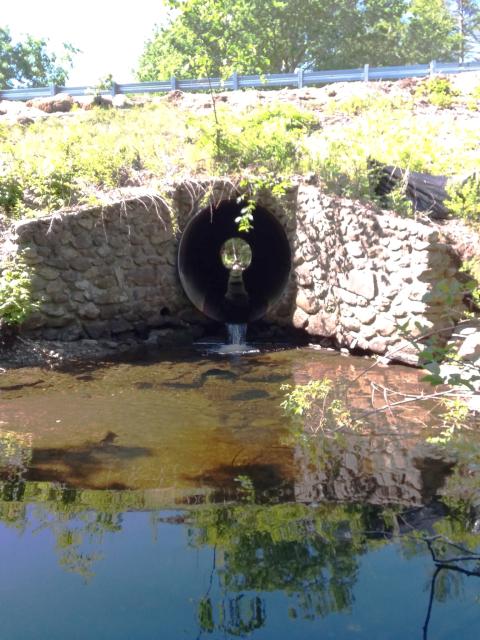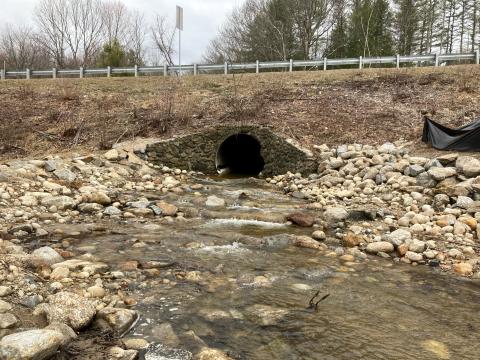Brook Trout Habitat Restoration Projects
Much of our work in the NH Fish & Game Department's Fisheries Habitat Program is providing technical assistance/expertise to our many partners, and together we restore and conserve fish habitat. Wild brook trout are a Species of Greatest Conservation Need in New Hampshire due to a number of threats to their populations including habitat degradation, restricted movement and climate change. For this newsletter, we highlight two restoration projects: habitat restoration using strategic wood additions to streams and reconnection of fish habitat using “fish ramps”.
Emerson Brook is a small, mountain stream in Nash Stream Forest in Stratford, NH. As part of the much larger Nash Stream Restoration Project with my esteemed colleague, Jim MacCartney, our work in Emerson was two-fold: restore the habitat and research the outcomes for wild brook trout there. The backstory is that most of our streams have very little naturally accumulated wood in them because it was actively removed 100+ years ago and past logging practices often cleared trees right up to streams. It takes decades or longer for trees to grow big, die and then fall into a stream. Research has focused on the role of downed wood in streams for fish habitat and also for retaining nutrients in the stream by reducing the flow of sediments downstream (we don’t want lots of phosphorous going downstream to our lakes). In 2009, 2012 and 2018, we carefully felled nearby trees, cut the logs to about ten foot lengths, and strategically placed them by hand into Emerson Brook. This is a common stream restoration technique across the country. Since then, we have conducted fish surveys nearly every year, and habitat surveys about every other year. What we observed is that the habitat changed very quickly – in just a few months – and the added wood helped the stream form pools, especially on the downstream side of the wood. That is where the trout were living, and we found that within a few years, our project had increased the trout population by about 5-10 times. Interestingly, we saw more changes over the next few years as some of the pools started to fill in with sand, and this resulted in fewer brook trout finding a home there. Still, fourteen years later, the habitat has not changed in the last five years and the trout population is about 2-3 times higher than before 2009, indicating that the long-term effect of our work was to at least double the natural brook trout population in Emerson Brook.

Emerson Brook one year after logs were added to this section of the stream. The wood has started to help the stream form pools and also retained a lot of leaves and small sticks, which are food and habitat for aquatic insects.
In Warner, NH, we reconnected several miles of Bartlett Brook to the mainstem of the Warner River by building two “fish ramps” in Bartlett Brook at the downstream end of two culverts under Route 89. Culverts are structures made of steel, concrete or plastic, and are often used under roads and trails to convey stormwater and streams. Unfortunately, they can block fish from swimming upstream. Just like us, fish need to move around to fulfill their life functions. Brook trout, in particular, have a penchant for moving upstream, sometimes miles, into cooler streams to avoid hot summer temperatures and also when it’s time to spawn in September/October. Because of this, it is particularly important that there are no barriers to them. NH Department of Transportation (NHDOT) needed to repair the two culverts and part of the work included making sure they are not barriers to fish. Since the culverts were already large enough to handle very high storm flows, there was not a need to replace them with larger culverts or bridges, which can be very costly. Tom Ballestero of UNH and Pete Kehoe of NHDOT designed the ramps. The ramps are comprised of natural sediments with six weirs comprised of large boulders. We added concrete to the weirs so that water always flowed over the weirs instead of under them. These were the first fish ramps built in New Hampshire, and therefore we needed to evaluate their effectiveness. They were built in summer 2020, and we conducted fish surveys in September 2020 and 2022 to see what fish species had moved upstream a few weeks and two years after project completion. Prior to the work, only two species, brook trout and blacknose dace, were upstream of both culverts. By 2022, five more fish species had ascended both culverts, and interestingly, many of the fish that did so were young-of-the-year (born that year) and were only 2-3 inches in length. This demonstrated that the ramps have worked very well, even for very small fish.

One of the Bartlett Brook culverts prior to construction work. The waterfall at the outlet of the pipe is about 18 inches high, and a barrier to fish.

About seven months after project completion. The weirs (lines of boulders) are difficult to see because we tried to make the ramps mimic a natural stream. Fish are able to ascend this ramp and culvert.
We and our partners learned a great deal from these two projects, highlighting the need to monitor the response of fish to our habitat restoration work. From Emerson Brook, it is clear that more wood equals more brook trout, and the amount of wood we added was still less than what would be expected in an untouched forest stream. Our experiences with the fish ramps tell us they are a viable option at many stream crossings to reconnect fish habitat, and this was a much less costly project than replacing the culverts with much bigger culverts or bridges.
All photos by John Magee, NH Fish & Game.

